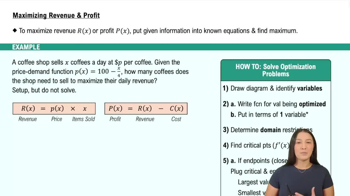Table of contents
- 0. Functions7h 52m
- Introduction to Functions16m
- Piecewise Functions10m
- Properties of Functions9m
- Common Functions1h 8m
- Transformations5m
- Combining Functions27m
- Exponent rules32m
- Exponential Functions28m
- Logarithmic Functions24m
- Properties of Logarithms34m
- Exponential & Logarithmic Equations35m
- Introduction to Trigonometric Functions38m
- Graphs of Trigonometric Functions44m
- Trigonometric Identities47m
- Inverse Trigonometric Functions48m
- 1. Limits and Continuity2h 2m
- 2. Intro to Derivatives1h 33m
- 3. Techniques of Differentiation3h 18m
- 4. Applications of Derivatives2h 38m
- 5. Graphical Applications of Derivatives6h 2m
- 6. Derivatives of Inverse, Exponential, & Logarithmic Functions2h 37m
- 7. Antiderivatives & Indefinite Integrals1h 26m
- 8. Definite Integrals4h 44m
- 9. Graphical Applications of Integrals2h 27m
- 10. Physics Applications of Integrals 2h 22m
5. Graphical Applications of Derivatives
Applied Optimization
Problem 4.5.6b
Textbook Question
Suppose S = x + 2y is an objective function subject to the constraint xy = 50, for x > 0 and y > 0.
b. Find the absolute minimum value of S subject to the given constraint.
 Verified step by step guidance
Verified step by step guidance1
First, express the constraint equation xy = 50 in terms of one variable. Solve for y in terms of x: y = 50/x.
Substitute y = 50/x into the objective function S = x + 2y to express S in terms of x alone: S = x + 2(50/x).
Simplify the expression for S: S = x + 100/x.
To find the critical points, take the derivative of S with respect to x. Use the power rule and the derivative of x^(-1) to find dS/dx.
Set the derivative dS/dx equal to zero and solve for x to find the critical points. Check these points to determine the absolute minimum value of S.
 Verified video answer for a similar problem:
Verified video answer for a similar problem:This video solution was recommended by our tutors as helpful for the problem above
Video duration:
6mPlay a video:
Was this helpful?
Key Concepts
Here are the essential concepts you must grasp in order to answer the question correctly.
Objective Function
An objective function is a mathematical expression that defines a quantity to be maximized or minimized. In this case, S = x + 2y is the objective function, which we aim to minimize while adhering to certain constraints. Understanding how to manipulate and evaluate this function is crucial for finding optimal solutions.
Recommended video:

Properties of Functions
Constraints
Constraints are conditions that the variables in an optimization problem must satisfy. Here, the constraint xy = 50 restricts the values of x and y, ensuring they remain positive. Recognizing how constraints affect the feasible region is essential for determining the minimum value of the objective function.
Recommended video:

Intro to Applied Optimization: Maximizing Area
Lagrange Multipliers
Lagrange multipliers are a method used in optimization to find the local maxima and minima of a function subject to equality constraints. This technique involves introducing a new variable (the multiplier) to incorporate the constraint into the optimization process. Applying this method will help in finding the absolute minimum value of S under the given constraint.
Recommended video:

Multiplying & Dividing Functions

 1:13m
1:13mWatch next
Master Intro to Applied Optimization: Maximizing Area with a bite sized video explanation from Callie
Start learningRelated Videos
Related Practice








